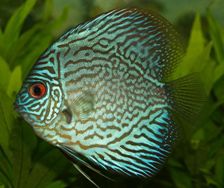Discus Cichlid
(Symphysodon Aequifasciatus)
Alternate Names:
Often named by color variations
 Discus Cichlid (Symphysodon Aequifasciatus) |
Size: Can grow to 8 Inches Temp Range: 78°F to 86°F ph Level: 6.0 to 7.5 Lifespan: 6 to 10 years Tank Size: 55 gallons Diet: Pellet, Flake, Frozen, Live Difficulty: Moderate to Hard |
Geographic History
These beautiful friends come from flood plain lakes and rivers in the Amazon River basin of Brazil, Colombia, and Peru.
Enviornment
This Cichlid needs excellent water quality and warm water in the upper extremes of their temperature range to stay healthy. They like slow or still water. Provide plants and maintain a stable Ph in the above range. You must do constant water changes to keep nitrate levels low because these fish are very sensitive to higher levels of this chemical. This may mean 20%-30% water changes two or three times a week, depending on the size of your aquarium.
Compatibility
Be careful of tank mates, such as gouramis, that may carry bacteria. Larger fish may injure these slow moving beauties and smaller fish may be eaten by them. Take care to keep them with like sized, non-aggressive species.
Sexing
Discus are very hard to sex as juveniles. Adult males have pointed dorsal and anal fins. The fins of females are much more rounded.
Behavior
In groups of two to four, one fish will become dominant. In groups of five or more, this is less apparent with a diminishing affect as more fish are added to the group. These are very peaceful fish and usually don't bother tank mates that they cannot eat.
Breeding
Discus will reach sexual maturity after two to three years. They breed in their home aquarium and should not be moved to a breeding tank. They usually spawn in the spring.
Usually, they will move into a corner of your aquarium to spawn. The female will lay eggs on flat rocks and they will hatch after about two days. Both parents help chew the fry out of their eggs, but will sometimes eat an egg. Once the fry are hatched, the parents transfer them to leaves for cover.
The fry will start swimming two to three days after they hatch. They will attach themselves to a parent for feeding. These fish produce a skin secretion that their fry feed on. The parents will transfer fry between each other to share in feeding duties. As the fry get larger, they will feed on baby brine shrimp and crushed flake food. Fry reach juvenile size and shape in around three months.
For more information, go to Wikipedia's Discus page.





